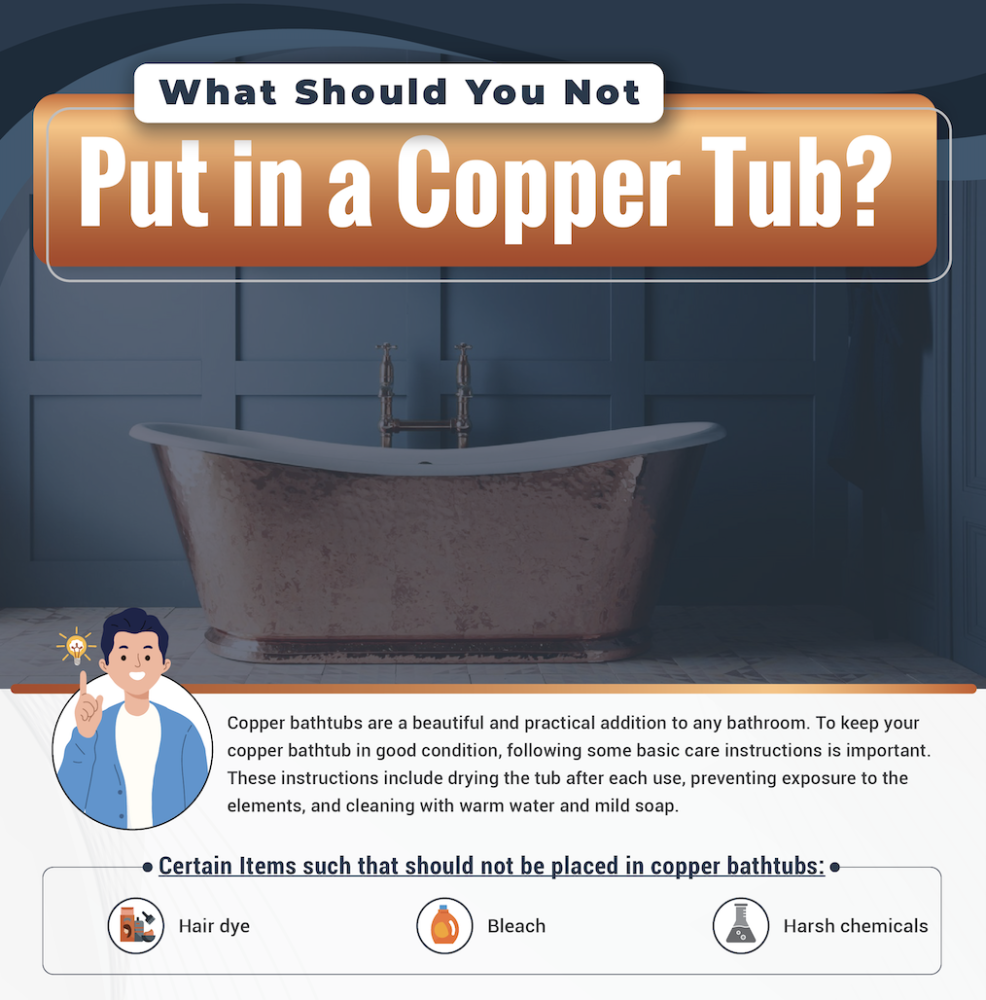
A copper bathtub is an attractive bathroom feature that adds visual appeal to the space while serving a practical purpose. A copper tub is also an investment. Upon installing a new copper bathtub in your home, one of your top goals may be to ensure it remains in good condition for years to come. You can achieve this goal partially by staying on top of upkeep. This involves such steps as:
- Drying the copper tub after every use
- Taking steps to prevent your copper bathtub from being exposed to the elements (such as keeping nearby windows closed when it’s raining)
- Cleaning your copper tub with warm water, mild soap, and a soft cloth from time to time
Those are just a few examples. An expert who supplies and/or installs copper bathtubs can offer additional upkeep tips if you have questions about this topic.
That said, along with cleaning your tub and practicing basic maintenance, protecting copper tubs involves knowing which types of items you shouldn’t place in one. The following are a few items that can potentially damage or discolor copper products if they come into contact with them:
Items You Shouldn’t Put in Copper Bathtubs
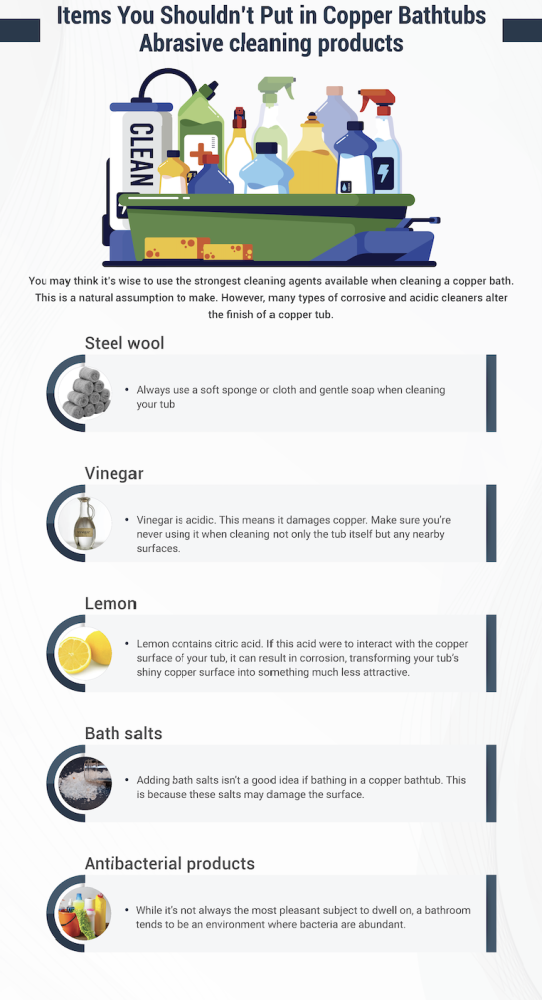
Abrasive cleaning products
You may think it’s wise to use the strongest cleaning agents available when cleaning a copper bath. This is a natural assumption to make. However, many types of corrosive cleaners and acidic cleaners alter the finish of a copper tub. Make sure you’re not using any cleaning agents that contain ammonia or bleach. Avoid using drain cleaning chemicals to deal with plumbing problems as well. When cleaning a drain with these products, it’s easy to accidentally spill some onto the tub itself. This can damage its surface. Again, the best way to clean a copper bath is to use mild soap, gentle water, and a soft cloth to wipe it all down.
This highlights one of the many benefits copper bathtubs offer. They’re relatively easy to clean and don’t require you to make use of costly cleaning agents. On the contrary, using such cleaning products when cleaning copper bathtubs is a bad idea.
Steel wool
Just as the wrong cleaning agents can damage the finish of your copper bathtub, so can steel wool. Always use a soft sponge or cloth along with gentle soap when cleaning your tub. Other types of cleaning items may scratch the copper.
Vinegar
Some people consider vinegar to be a go-to cleaning agent that can thoroughly clean a surface without causing damage. While it’s true that vinegar can be useful when you’re cleaning various other surfaces around your home, it’s not something you should use when cleaning a copper bath.
Vinegar is acidic. This means it damages copper. Make sure you’re never using it when cleaning not only the tub itself, but any nearby surfaces. For example, if you were to use vinegar when cleaning the floor or wall near your tub, you could accidentally allow some vinegar to drip or splash into the tub. It’s therefore best to use other types of cleaning products when cleaning any surface in your bathroom.
Lemon
Choosing the right cleaning products to help maintain your copper tub without damaging it is essential. It’s also critical that you be familiar with what you can and can’t add to a bath in a copper tub. For example, some people add lemon to their baths. This is not a good idea when bathing in a copper bathtub.Lemon contains citric acid. If this acid were to interact with the copper surface of your tub, it can result in corrosion, transforming your tub’s shiny copper surface into something much less attractive.
(Tip: You might add bath bath oils to a bath to make it even more relaxing. If so, carefully check the ingredients of these products before using them. You don’t want to accidentally use a product that contains an ingredient which can potentially harm your tub.)
Bath salts
Adding bath salts to a bath isn’t a good idea if you’re bathing in a copper bathtub. This is because these salts may damage the surface. Fortunately, copper retains heat very well. This ensures it delivers a relaxing bath without requiring you to add salts or other such products. The steady warmth of the water itself should be enough to help you relax.
Antibacterial products
While it’s not always the most pleasant subject to dwell on, the fact is, a bathroom tends to be an environment where bacteria are abundant. That’s why cleaning your bathroom regularly is so vital. Doing so doesn’t merely preserve the appearance of your bathroom—it may also guard against health problems.
However, when cleaning your bathtub itself, you may not need to use antibacterial products. These products could contain ingredients that could damage the tub.
Luckily, copper itself is naturally antibacterial. Research confirms that bacteria doesn’t survive on copper for very long when compared to other types of surfaces.
This is why some homeowners also install copper sinks when installing new tubs. Doing so gives them the peace of mind that comes from knowing they’re washing their hands over and around a fixture that itself is likely to be relatively bacteria-free.
Cleaning Copper Tubs: Additional Tips to Consider
The above list specifies what types of products you shouldn’t use when cleaning a copper bathtub. The following additional copper product cleaning tips will help you maintain your copper effectively while keeping yourself safe as well:
Wear gloves when cleaning copper baths with detergent
A mild detergent or soap is the best cleaning agent for copper products. That said, even a mild detergent can cause some irritation if it comes into contact with your skin. Strongly consider wearing gloves and long sleeves when cleaning any copper product to guard against this.
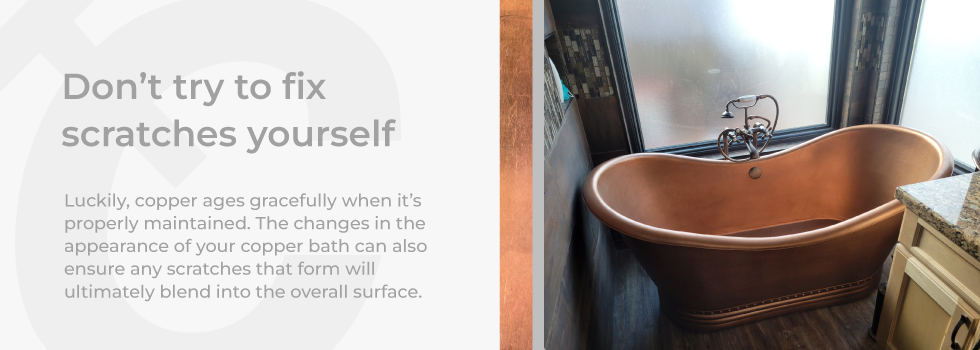
Don’t try to fix scratches yourself
If you follow the advice here, you may avoid scratching your tub when cleaning it. Unfortunately, mistakes can still happen. You might be tempted to try fixing a scratch yourself if one forms. Don’t make this error. Copper’s color changes naturally over time. While you can practice basic upkeep to preserve the look of your copper bath, be aware that its appearance will change as years go by.
Luckily, copper ages gracefully when it’s properly maintained. The changes in the appearance of your copper bath can also ensure any scratches that form will ultimately blend into the overall surface.
On the other hand, if you try to remove a scratch yourself, you might simply end up scratching your copper bath even more. If removing a scratch is vital, contact an expert to see if they can do anything to help.
Wax your copper to avoid mineral deposits
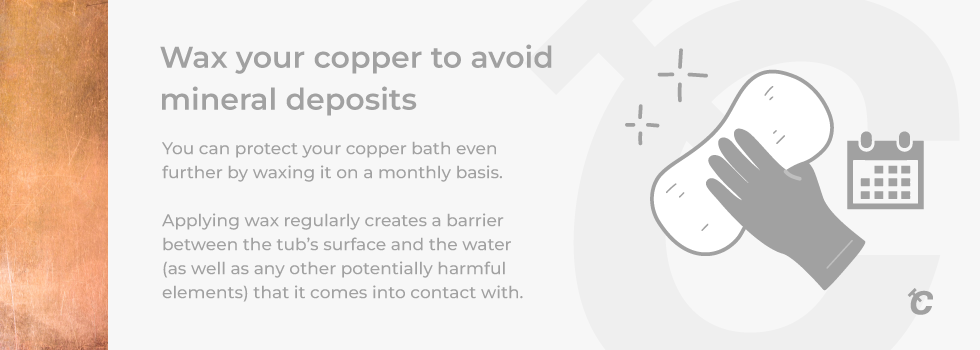
The water in your area may have a high mineral content. If this is the case, over time, mineral deposits may form on the surface of your copper bath. This can result in the surface developing a film. Preventing this involves drying your copper bathtub after every use, as recommended earlier. This ensures mineral-rich water is cleared away before deposits can accumulate.
You can protect your copper bath even further by waxing it on a monthly basis. Applying wax regularly creates a barrier between the tub’s surface and the water (as well as any other potentially harmful elements) that it comes into contact with.
Just make sure you’re applying a wax that’s designed specifically for use on copper baths and copper products in general. Read the directions carefully to ensure you’re using the product correctly.
Protecting Copper Baths: Essential Information
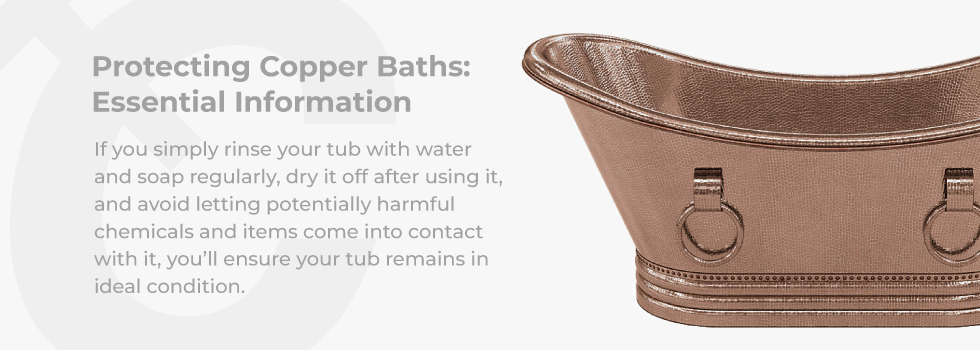
There are many reasons to opt for copper when deciding which material your new bathtub should be made of. Once more, copper is gorgeous, timeless, and on top of that, it’s a great heat conductor but not a fast heat radiator. This means it heats up quickly but doesn’t lose heat quickly.
If you’re choosing to upgrade to a copper bathtub, you naturally want to know how you can optimize its looks and lifespan. This requires knowing how to protect its surface.
Again, this need not be a challenging task. If you simply rinse your tub with water and soap regularly, dry it off after using it, and avoid letting potentially harmful chemicals and items come into contact with it, you’ll ensure your tub remains in ideal condition. Remember, you can also always get in touch with an expert if you ever have any more questions about this subject or any of our other product products like our range hoods!
